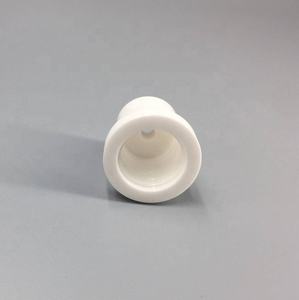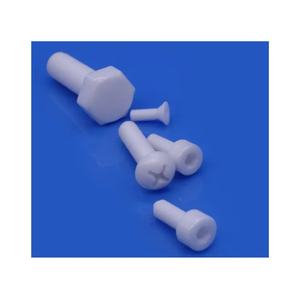1. Product Fundamentals and Microstructural Layout
1.1 Make-up and Crystallographic Stability of Alumina
(Alumina Ceramic Nozzles)
Alumina (Al ₂ O FOUR), particularly in its alpha stage, is a completely oxidized ceramic with a corundum-type hexagonal close-packed structure, providing remarkable thermal stability, chemical inertness, and mechanical toughness at raised temperatures.
High-purity alumina (normally 95– 99.9% Al Two O ₃) is liked for nozzle applications due to its marginal impurity web content, which lowers grain boundary weakening and enhances resistance to thermal and chemical degradation.
The microstructure, containing fine, equiaxed grains, is crafted throughout sintering to reduce porosity and make best use of density, directly influencing the nozzle’s erosion resistance and architectural honesty under high-velocity liquid flow.
Ingredients such as MgO are commonly presented in trace total up to hinder unusual grain growth throughout sintering, guaranteeing an uniform microstructure that sustains long-term reliability.
1.2 Mechanical and Thermal Properties Relevant to Nozzle Efficiency
Alumina ceramics show a Vickers solidity exceeding 1800 HV, making them very immune to abrasive wear from particulate-laden liquids, an essential feature in applications such as sandblasting and rough waterjet cutting.
With a flexural strength of 300– 500 MPa and a compressive toughness over 2 GPa, alumina nozzles keep dimensional security under high-pressure operation, typically varying from 100 to 400 MPa in commercial systems.
Thermally, alumina retains its mechanical homes as much as 1600 ° C, with a reduced thermal expansion coefficient (~ 8 × 10 ⁻⁶/ K) that gives exceptional resistance to thermal shock– necessary when revealed to fast temperature fluctuations throughout start-up or shutdown cycles.
Its thermal conductivity (~ 30 W/m · K) suffices to dissipate localized heat without causing thermal slopes that could lead to fracturing, stabilizing insulation and warm monitoring demands.
2. Production Processes and Geometric Precision
2.1 Shaping and Sintering Strategies for Nozzle Construction
The manufacturing of alumina ceramic nozzles begins with high-purity alumina powder, which is processed into an environment-friendly body making use of approaches such as cool isostatic pressing (CIP), shot molding, or extrusion, depending on the wanted geometry and batch size.
( Alumina Ceramic Nozzles)
Cold isostatic pushing uses uniform pressure from all instructions, producing a homogeneous thickness distribution important for minimizing defects during sintering.
Injection molding is utilized for complicated nozzle forms with internal tapers and fine orifices, permitting high dimensional precision and reproducibility in automation.
After forming, the environment-friendly compacts undertake a two-stage thermal therapy: debinding to remove natural binders and sintering at temperature levels in between 1500 ° C and 1650 ° C to attain near-theoretical density with solid-state diffusion.
Specific control of sintering environment and heating/cooling rates is important to prevent warping, cracking, or grain coarsening that can endanger nozzle performance.
2.2 Machining, Polishing, and Quality Control
Post-sintering, alumina nozzles frequently require accuracy machining to accomplish limited tolerances, particularly in the orifice area where flow characteristics are most conscious surface coating and geometry.
Ruby grinding and splashing are utilized to refine interior and exterior surfaces, accomplishing surface roughness values below 0.1 µm, which lowers circulation resistance and prevents fragment build-up.
The orifice, normally ranging from 0.3 to 3.0 mm in size, must be devoid of micro-cracks and chamfers to ensure laminar circulation and constant spray patterns.
Non-destructive testing methods such as optical microscopy, X-ray inspection, and pressure biking tests are used to validate structural honesty and performance consistency before deployment.
Customized geometries, consisting of convergent-divergent (de Laval) accounts for supersonic flow or multi-hole arrays for fan spray patterns, are increasingly made utilizing sophisticated tooling and computer-aided design (CAD)-driven production.
3. Useful Advantages Over Different Nozzle Materials
3.1 Superior Erosion and Corrosion Resistance
Contrasted to metal (e.g., tungsten carbide, stainless steel) or polymer nozzles, alumina shows far greater resistance to unpleasant wear, specifically in atmospheres including silica sand, garnet, or other difficult abrasives made use of in surface prep work and cutting.
Metal nozzles break down swiftly due to micro-fracturing and plastic contortion, needing frequent replacement, whereas alumina nozzles can last 3– 5 times much longer, considerably decreasing downtime and operational prices.
Additionally, alumina is inert to many acids, antacid, and solvents, making it ideal for chemical splashing, etching, and cleaning procedures where metallic parts would corrode or pollute the fluid.
This chemical security is particularly useful in semiconductor manufacturing, pharmaceutical processing, and food-grade applications calling for high purity.
3.2 Thermal and Electrical Insulation Characteristic
Alumina’s high electrical resistivity (> 10 ¹⁴ Ω · centimeters) makes it excellent for use in electrostatic spray coating systems, where it prevents charge leakage and makes certain uniform paint atomization.
Its thermal insulation capacity allows risk-free operation in high-temperature splashing settings, such as flame splashing or thermal cleansing, without warmth transfer to bordering components.
Unlike steels, alumina does not militarize unwanted chemical reactions in responsive fluid streams, maintaining the stability of delicate solutions.
4. Industrial Applications and Technological Effect
4.1 Roles in Abrasive Jet Machining and Surface Area Treatment
Alumina ceramic nozzles are important in unpleasant blasting systems for corrosion removal, paint stripping, and surface area texturing in automotive, aerospace, and building and construction industries.
Their ability to preserve a regular orifice size over expanded usage ensures consistent abrasive velocity and influence angle, straight affecting surface area coating top quality and procedure repeatability.
In rough waterjet cutting, alumina focusing tubes direct the high-pressure water-abrasive mix, enduring erosive forces that would swiftly degrade softer products.
4.2 Usage in Additive Manufacturing, Spray Layer, and Liquid Control
In thermal spray systems, such as plasma and flame splashing, alumina nozzles straight high-temperature gas flows and molten fragments onto substratums, taking advantage of their thermal shock resistance and dimensional stability.
They are also employed in precision spray nozzles for farming chemicals, inkjet systems, and fuel atomization, where wear resistance makes certain lasting dosing precision.
In 3D printing, specifically in binder jetting and material extrusion, alumina nozzles deliver great powders or thick pastes with very little blocking or put on.
Arising applications consist of microfluidic systems and lab-on-a-chip tools, where miniaturized alumina parts supply sturdiness and biocompatibility.
In summary, alumina ceramic nozzles represent a crucial intersection of products scientific research and commercial engineering.
Their exceptional combination of firmness, thermal security, and chemical resistance allows reliable performance in a few of one of the most requiring fluid handling atmospheres.
As industrial processes press towards higher stress, finer resistances, and longer solution intervals, alumina ceramics continue to establish the standard for resilient, high-precision circulation control parts.
5. Distributor
Alumina Technology Co., Ltd focus on the research and development, production and sales of aluminum oxide powder, aluminum oxide products, aluminum oxide crucible, etc., serving the electronics, ceramics, chemical and other industries. Since its establishment in 2005, the company has been committed to providing customers with the best products and services. If you are looking for high quality spherical alumina, please feel free to contact us. (nanotrun@yahoo.com)
Tags: Alumina Ceramic Nozzles, Ceramic Nozzles, Alumina Nozzles
All articles and pictures are from the Internet. If there are any copyright issues, please contact us in time to delete.
Inquiry us






